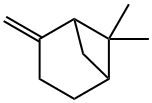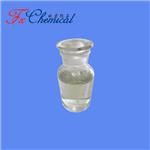Chemical Properties
β-Pinene occurs
in many essential oils. Optically active and racemic β-pinenes are present
in turpentine oils, although in smaller quantities than αα-pinene. (+)-β-Pinene,
(1R,5R)-6,6-dimethyl-2-methylenebicyclo(3.1.1)heptane,; (?)-β-Pinene, (1S,5S)-6,6-dimethyl-2-methylenebicyclo(3.1.1)heptane,.
β-Pinene is similar to α-pinene in its reactions. Pyrolytic cleavage to myrcene,
the startingmaterial for acyclic terpenes, is used on an industrial scale.Addition of
formaldehyde results in the formation of nopol; nopyl acetate is used as a fragrance
material. β-Pinene is produced in large quantities by distillation of turpentine oils.
It is used as a fragrance material in household perfumery.However,most β-pinene
is used in the production of myrcene.
Occurrence
Usually occurring together with α-pinene but in smaller amounts; the d- and l-forms are reported found in the
essential oils of various Artemisae and several Cupressaceae, in coriander and cumin; the l-form is a constituent of several citrus
oils. β-Pinene is reported found in over 190 natural products including apple, apricot, many citrus juices and peel oils, bilberry, cranberry,
lingonberry, blackberry, currants, guava, raspberry, strawberry, basil, carrot, celery, cooked potato, bell pepper, tomato, anise
seed oil, cinnamon, cassia leaf, clove, cumin, ginger, Mentha oils, nutmeg, mace, pepper, parsley, thyme, Swiss and cheddar cheese,
cream, fatty fish, fried chicken, beef fat, hop oil, rum, bourbon whiskey, tea, roasted filberts, pecans, oats, soybean, plum, mushroom,
sweet and wild marjoram, starfruit, mango, tamarind, cardamom, coriander, gin, rice, litchi, calamus, dill, lovage, caraway seed,
buckwheat, laurel, fennel, kiwifruit, myrtle leaf and berry, rosemary, buchu oil, Bourbon vanilla, Spanish and clary sage, nectarine,
crayfish, clam, cape gooseberry, anise hyssop, angelica root oil, Roman and German chamomile oil, eucalyptus oil, bullock’s heart
and mastic gum leaf and fruit oil.







